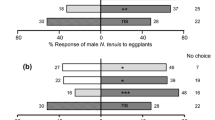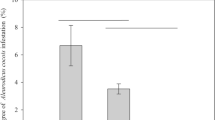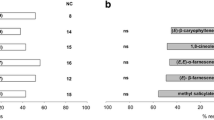Abstract
Attraction of both sexes ofIps plastographus maritimus Lanier to bark-phloem-xylem discs of Monterey pine,Pinus radiata D. Don, was demonstrated in the laboratory. Increasing concentrations of male and female volatiles trapped separately and released in a one-to-one ratio decreased attraction for both sexes combined. Attraction of both sexes to volatiles derived from males and females tunneling together in a one-to-one ratio increased with increasing concentration of extract. Attraction of males and females to male-infested discs and to trapped male volatiles increased with increasing dose of males or male extract. Attraction of males and females to female-infested discs and to trapped female volatiles was also demonstrated. The presence of females in male galleries reduced the attractiveness of infested disks to both sexes combined. Increasing numbers of females, tunneling separately from males in the same disc, reduced attraction of males, but not females. When a constant attractive dose of male volatiles was released with increasing doses of female volatiles, there was no difference in response of either sex when female volatiles were present compared with the response to male volatiles alone. When a constant attractive dose of male volatiles was released with increasing concentrations of volatiles derived from males and females tunneling together in a one-to-one ratio, attraction ofI. p. maritimus decreased. Response of females was frequently higher than that of males to the same attractant source. Hence, both sexes produce an attractant, and both sexes tunneling together in the same gallery reduce attraction of males and females to an attractive dose of male attractant.
Similar content being viewed by others
References
Akers, R. P. 1989. Counterturns initiated by decrease in rate of increase of concentration: Possible mechanism of chemotaxis by walking femaleIps paraconfusus bark beetles.J. Chem. Ecol. 15:183–208.
Akers, R. P., andWood, D. L. 1989. Olfactory orientation responses by walking femaleIps paraconfusus. II. In an anemotaxis assay.J. Chem. Ecol. 15:1147–1159.
Akers, R. P., Preisler, H. M., andWood, D. L. 1993. Interactions between components of the aggregation pheromone during chemotaxis by the bark beetleIps paraconfusus.J. Chem. Ecol. 19:863–879.
Anderson, R. F. 1948. Host selection by the pine engraver.J. Econ. Entomol. 41:596–602.
Barr, B. A. 1969. Sound production in the Scolytidae (Coleoptera) with emphasis on the genusIps.Can. Entomol. 101:636–672.
Birch, M. C., Tilden, P. E., Wood, D. L., Browne, L. E., Young, J. C., andSilverstein, R. M. 1977. Biological activity of compounds isolated from air condensates and from the bark beetle,Ips confusus.J. Insect Physiol. 23:1373–1376.
Birch, M. C., Light, D. M., Wood, D. L., Browne, L. E., Silverstein, R. M., Bergot, B. J., Ohloff, G., West, J. R., andYoung, J. C. 1980. Pheromonal response and allomonal interruption ofIps pini in California by the two enantiomers of ipsdienol.J. Chem. Ecol. 6:703–717.
Borden, J. H. 1967. Factors influencing the response ofIps confusus to male attractant.Can. Entomol. 99:1164–1193.
Borden, J. H. 1985. Aggregation pheromones, pp. 257–285,in G. A. Kerkut and L. I. Gilbert (eds.). Comprehensive Insect Physiology, Biochemistry, and Pharmacology. Pergamon Press, Oxford.
Bright, D. E., Jr., andStark, R. W. 1973. The bark and ambrosia beetles of California. Coleoptera: Scolytidae and Platypodidae. Bulletin of the California Insect Survey. Volume 16. University of California Press, 169 pp.
Browne, L. E. 1972. An emergence cage and refrigerated collector for wood boring insects and their associates.J. Econ. Entomol. 65:1499–1501.
Byers, J. A. 1981. Effect of mating on terminating aggregation during host colonization in the bark beetle,Ips paraconfusus.J. Chem. Ecol. 7:1135–1147.
Byers, J. A., 1989. Behavioral mechanisms involved in reducing competition in bark beetles.Holarctic Ecol. 12:466–476.
Byers, J. A., Wood, D. L., Craig, J., andHendry, L. B. 1984. Attractive and inhibitory pheromones produced in the bark beetleDendroctonus brevicomis, during host colonization.J. Chem. Ecol. 10:861–877.
Byers, J. A., Lanne, B. S., Löfqvist, J., Schlyter, F., andBergström, G. 1985. Olfactory recognition of host-tree susceptibility by pine shoot beetles.Naturwissenschaften 72:324–326.
Edson, L. J. 1978. Host colonization and arrival sequence of the mountain pine beetle and its insectan associates. PhD thesis. University of California, Berkeley, 196 pp.
Fox, J. W., Wood, D. L., Koehler, C. S., andO'Keefe, S. T. 1991. Engraver beetles (Scolytidae:Ips species) as vectors of the pitch canker fungus,Fusarium subglutinans.Can. Entomol. 123:1355–1367.
Gast, S. J., Stock, M. W., andFurniss, M. M. 1993. Physiological factors affecting attraction ofIps pini (Coleoptera: Scolytidae) to host odor or natural male pheromone in Idaho.Ann. Entomol. Soc. Am. 86:417–422.
Gregoire, J. C., 1988. The greater European spruce bark beetle, pp. 455–478,in A. A. Berryman (ed.). Dynamics of Forest Insect Populations, Patterns, Causes, Implications. Plenum, New York.
Johnson, P. C. 1954. A hibernation record ofIps plastographus LeConte (Coleoptera: Scolytidae).Can. Entomol. 86:431–432.
Lanier, G. N. 1967.Ips plastographus (Coleoptera: Scolytidae) tunnelling in sapwood of lodgepole pine in California.Can. Entomol. 99:1334–1335.
Lanier, G. N. 1970. Biosystematics of the genus Ips (Coleoptera: Scolytidae) in North America. Hopping's group III.Can. Entomol. 102:1404–1423.
Lanier, G. N., andCameron, E. A. 1969. Secondary sexual characters in the North American species of the genusIps (Coleoptera: Scolytidae).Can. Entomol. 101:862–870.
Lanier, G. N., andWood, D. L. 1975. Specificity of response to pheromones in the genusIps (Coleoptera: Scolytidae).J. Chem. Ecol. 1:9–23.
Lanier, G. N., Teale, S. A., andPajares, J. A. 1991. Biosystematics of the genusIps (Coleoptera: Scolytidae) in North America: Review of theIps calligraphus group.Can. Entomol. 123:1103–1124.
McCain, A. H., Koehler, C. S., andTjosvold, S. A. 1987. Pitch canker threatens California pines.Calif. Agric. 41:22–23.
Miller, D. R., andBorden, J. H., 1990. The use of monoterpenes as kairomones byIps latidens (LeConte) and byIps pini (Say) (Coleoptera: Scolytidae).J. Chem. Ecol. 17:1517–1527.
Miller, D. R., Madden, J. L., andBorden, J. H. 1986. Primary attraction ofIps latidens (LeConte) andHylastes gracilis LeConte (Colcoptera: Scolytidae) to high-girdled lodgepole pine,Pinus contorta var.latifolia Engelmann.Can. Entomol. 118:85–88.
Moeck, H. A., Wood, D. L., andLindahl, K. Q., Jr. 1981. Host selection behavior of bark beetles attackingPinus ponderosa with special emphasis on the western pine beetle,Dendroctonus brevicomis.J. Chem. Ecol. 7:49–83.
Raffa, K. F., Phillips, T. W., andSalmon, S. M. 1993. Strategies and mechanisms of host colonization by bark beetles, pp. 103–128,in T. D. Schowalter and G. M. Filip, (eds.). Beetle-Pathogen Interactions in Conifer Forests. Academic Press, London.
Rudinsky, J. A. 1969. Masking of the aggregation pheromone inDendroctonus pseudotsugae Hopkins.Science 166:884–885.
Seybold, S. J. 1992. The role of chirality in the olfactory-directed aggregation behavior of pine engraver beetles in the genusIps (Coleoptera: Scolytidae). PhD thesis, University of California, Berkeley, 355 pp.
Siegel, S. 1956. Nonparametric Statistics for the Behavioral Sciences. McGraw-Hill, New York, 312 pp.
Silverstein, R. M. 1977, Complexity, diversity and specificity of behavior-modifying chemicals: Examples mainly from Coleoptera and Hymenoptera, pp. 231–251,in H. H. Shorey, and J. J. McKelvey, Jr. (eds.). Chemical Control of Insect Behavior: Theory and Application. John Willey & Sons, New York.
Silverstein, R. M., Rodin, J. O., andWood, D. L. 1966. Sex attractants in frass produced by maleIps confusus in ponderosa pine.Science 154:509–510.
Sokal, R. R., andRohlf, F. J. 1981. Biometry, 2nd ed. W. H. Freeman, New York, 859 pp.
Storer, A. J., andDallara, P. L. 1992. Pitch canker disease in California. California Department of Forestry and Fire Protection, Tree Note Number 15, 2 pp.
Werner, R. A. 1971. Aggregation behavior of the beetleIps grandicollis in response to host-produced attractants.J. Insect Physiol. 18:423–437.
Werner, R. A. 1972. Response of the beetle,Ips grandicollis, to combinations of host and insect produced attractants.J. Insect Physiol. 18:1403–1412.
Wood, D. L. 1962. The response created by males of a bark beetleIps confusus attacking ponderosa pine (Coleoptera: Scolytidae).Pan-Pac. Entomol. 38:141–145.
Wood, D. L. 1982. The role of pheromones, kairomones, and allomones in the host selection and colonization behavior of bark beetles.Annu. Rev. Entomol. 27:411–446.
Wood, D. L., andVite, J. P. 1961. Studies on the host selection behavior ofIps confusus (LeConte) (Coleoptera: Scolytidae) attackingPinus ponderosa.Contrib. Boyce Thompson Inst. 21:79–96.
Wood, D. L., andBushing, R. W. 1963. The olfactory response ofIps confusus (LeConte) to the secondary attraction in the laboratory.Can. Entomol. 95:1066–1078.
Wood, D. L., Browne, L. E., Silverstein, R. M., andRodin, J. O. 1966. Sex pheromones of bark beetles. I. Mass production, bio-assay, source, and isolation of sex pheromones ofIps confusus (LeC).J. Insect Physiol. 12:523–536.
Wood, D. L., Stark, R. W., Silverstein, R. M., andRodin, J. O. 1967. Unique synergistic effects produced by the principal sex attractant compounds ofIps confusus (LeConte).Nature 215:206.
Wood, D. L., Browne, L. E., Bedard, W. D., Tilden, P. E., Silverstein, R. M., andRodin, J. O. 1968. Response ofIps confusus to synthetic sex pheromones in nature.Science 159:1373–1374.
Wood, S. L. 1982. The bark and ambrosia beetles of North and Central America (Coleoptera: Scolytidae), a taxonomic monograph.Great Basin Naturalist No. 6, 1359 pp.
Zar, J. H. 1984. Biostatistical Analysis, 2nd ed. Prentice Hall, Engelwood Cliffs, New Jersey, 718 pp.
Author information
Authors and Affiliations
Rights and permissions
About this article
Cite this article
Warren, C.E., Wood, D.L., Seybold, S.J. et al. Olfactory responses ofIps plastographus maritimus lanier (coleoptera: Scolytidae) to insect and host-associated volatiles in the laboratory. J Chem Ecol 22, 2299–2316 (1996). https://doi.org/10.1007/BF02029548
Received:
Accepted:
Issue Date:
DOI: https://doi.org/10.1007/BF02029548




